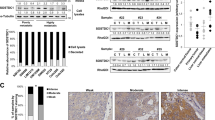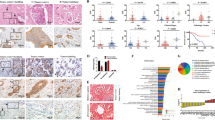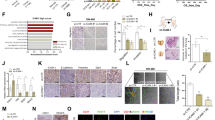Abstract
Matrilysin (MMP-7) is thought to contribute to invasive growth and metastasis of colon carcinoma and many other human cancers. The present study demonstrates that treatment of human colon carcinoma cells with active matrilysin induces cell aggregation in vitro and promotes liver metastasis in nude mice. When two kinds of colon carcinoma cell lines were incubated with active matrilysin, this enzyme efficiently bound to the cell surface and induced loose cell aggregation, which led to E-cadherin-mediated tight cell aggregation. Synthetic MMP inhibitors inhibited both the membrane binding of matrilysin and matrilysin-induced cell aggregation, while TIMP-2 inhibited only the cell aggregation. Two other active MMPs, stromelysin and gelatinase A, neither bound to cell membrane nor induced cell aggregation. Tumor cells in loose cell aggregates could reaggregate even after they were freed from matrilysin and dispersed. When injected into the spleen of nude mice, the tumor cells in the stable aggregates produced much larger metastatic nodules in the livers than control cells and those in the loose aggregates. These results suggest that matrilysin may enhance metastatic potential of tumor cells by processing a cell surface protein(s) and thereby inducing loose and then tight aggregation of tumor cells.
This is a preview of subscription content, access via your institution
Access options
Subscribe to this journal
Receive 50 print issues and online access
$259.00 per year
only $5.18 per issue
Buy this article
- Purchase on Springer Link
- Instant access to full article PDF
Prices may be subject to local taxes which are calculated during checkout









Similar content being viewed by others

References
Abdel-Ghany M, Cheng HC, Elble RC and Pauli BU . (2001). J. Biol. Chem., 276, 25438–25446.
Adachi Y, Yamamoto H, Itoh F, Hinoda Y, Okada Y and Imai K . (1999). Gut, 45, 252–258.
Agnihotri R, Crawford HC, Haro H, Matrisian LM, Havrda MC and Liaw L . (2001). J. Biol. Chem., 276, 28261–28267.
Aono S, Nakagawa S, Reynolds AB and Takeichi M . (1999). J. Cell Biol., 145, 551–562.
Belaaouaj AA, Li A, Wun TC, Welgus HG and Shapiro SD . (2000). J. Biol. Chem., 275, 27123–27128.
von Bredow DC, Nagle RB, Bowden GT and Cress AE . (1997). Exp. Cell Res., 236, 341–345.
Brooks PC, Strömblad S, Sanders L, von Schalscha TK, Aimes TL, Stetler-Stevenson WG, Quigley JP and Cheresh DA . (1996). Cell, 85, 683–693.
Browner MF, Smith WW and Castelhano AL . (1995). Biochemistry, 34, 6602–6610.
Caterson B, Flannery CR, Hughes CE and Little CB . (2000). Matrix Biol., 19, 333–344.
Chen WT . (1996). Enzyme Protein, 49, 59–71.
Davies G, Jiang WG and Mason MD . (2001). Clin. Cancer Res., 7, 3289–3297.
Gearing JHA, Thorpe JS, Miller K, Mangan M, Varley GP, Dudgeon T, Ward G, Turner C and Thorpe R . (2002). Immunol. Lett., 81, 41–48.
Giannelli G, Falk-Marzillier J, Schiraldi O, Stetler-Stevenson WG and Quaranta V . (1997). Science, 277, 225–228.
Hasegawa S, Koshikawa N, Momiyama N, Moriyama K, Ichikawa Y, Ishikawa T, Mitsuhashi M, Shimada H and Miyazaki K . (1998). Int. J. Cancer, 76, 812–816.
Higashi S and Miyazaki K . (1999). J. Biol. Chem., 274, 10497–10504.
Higashi S and Miyazaki K . (2003). J. Biol. Chem., 278, 14020–14028.
Inch WR, McCredie JA and Sutherland RM . (1970). Growth, 34, 271–282.
Inohara H, Akahani S, Koths K and Raz A. . (1996). Cancer Res., 56, 4530–4534.
Ishikawa T, Ichikawa Y, Mitsuhashi M, Momiyama N, Chishima T, Tanaka K, Yamaoka H, Miyazaki K, Nagashima Y, Akitaya T and Shimada H . (1996). Cancer Lett., 107, 5–10.
Kantak SS and Kramer RH . (1998). J. Biol. Chem., 273, 16953–16961.
Kondo K, Kohno N, Yokoyama A and Hiwada K . (1998). Cancer Res., 58, 2014–2019.
Mitsiades N, Yu WH, Poulaki V, Tsokos M and Stamenkovic I . (2001). Cancer Res., 61, 577–581.
Miyata S, Koshikawa N, Yasumitsu H and Miyazaki K . (2000). J. Biol. Chem., 275, 4592–4598.
Miyazaki K, Hattori Y, Umenishi F, Yasumitsu H and Umeda M . (1990). Cancer Res., 50, 7758–7764.
Monz B, Karbach U, Groebe K and Mueller-Klieser W . (1996). Oncol. Rep., 1, 1177–1183.
Mueller-Klieser W . (1997). Am. J. Physiol., 273, C1109–C1123.
Mueller S, Cadenas E and Schonthal AH . (2000). Cancer Res., 60, 156–163.
Nagase H and Woessner Jr JF . (1999). J. Biol. Chem., 274, 21491–21494.
Nagashima Y, Hasegawa S, Koshikawa N, Taki A, Ichikawa Y, Kitamura H, Misugi K, Kihira Y, Matuo Y, Yasumitsu H and Miyazaki K . (1997). Int. J. Cancer, 72, 441–445.
Noe V, Fingleton B, Jacobs K, Crawford HC, Vermeulen S, Steelant W, Bruyneel E, Matrisian LM and Mareel M . (2001). J. Cell Sci., 114, 111–118.
Noguchi P, Wallace R, Johnson J, Earley EM, O'Brien S, Ferrone S, Pellegrino MA, Milstien J, Needy C, Browne W and Petricciani J . (1979). In Vitro, 15, 401–408.
Olive PL and Banath JP . (1997). Cancer Res., 57, 5528–5533.
Semple TU, Quinn LA, Woods LK and Moore GE . (1978). Cancer Res., 38, 1345–1355.
Takahashi C, Sheng Z, Horan TP, Kitayama H, Maki M, Hitomi K, Kitaura Y, Takai S, Sasahara RM, Horimoto A, Ikawa Y, Ratzkin BJ, Arakawa T and Noda M . (1998). Proc. Natl. Acad. Sci. USA, 95, 13221–13226.
Takeda T, Go WY, Orlando RA and Farquhar MG . (2000). Mol. Biol. Cell, 11, 3219–3232.
Takeichi M . (1993). Curr. Opin. Cell. Biol., 5, 806–811.
Umenishi F, Yasumitsu H, Ashida Y, Yamauti J, Umeda M and Miyazaki K . (1990). J. Biochem. (Tokyo), 108, 537–543.
Welch AR, Holman CM, Huber M, Brenner MC, Browner MF and Van Wart HE . (1996). Biochemistry, 35, 10103–10109.
Werb Z . (1997). Cell, 91, 439–442.
Wilson CL, Ouellette AJ, Satchell DP, Ayabe T, Lopez-Boado YS, Stratman JL, Hultgren SJ, Matrisian LM and Parks WC . (1999). Science, 286, 113–117.
Yoshimoto M, Itoh F, Yamamoto H, Hinoda Y, Imai K and Yachi A . (1993). Int. J. Cancer, 54, 614–618.
Yu Q and Stamenkovic I . (2000). Genes Dev., 14, 163–176.
Yu WH and Woessner Jr JF . (2000). J. Biol. Chem., 275, 4183–4191.
Yu WH, Woessner Jr JF, McNeish DJ and Stamenkovic I . (2002). Genes Dev., 16, 307–323.
Acknowledgements
We are grateful to Mr J Tsunezumi, Miss K Moriyama, and Dr S Hasegawa for technical support and Drs H Yasumitsu and Y Tsubota for helpful suggestions and discussions. This work was supported in part by Grants-in-Aid from the Ministry of Education, Culture, Sports, Science and Technology and from the Ministry of Welfare and Labor of Japan.
Author information
Authors and Affiliations
Corresponding author
Rights and permissions
About this article
Cite this article
Kioi, M., Yamamoto, K., Higashi, S. et al. Matrilysin (MMP-7) induces homotypic adhesion of human colon cancer cells and enhances their metastatic potential in nude mouse model. Oncogene 22, 8662–8670 (2003). https://doi.org/10.1038/sj.onc.1207181
Received:
Revised:
Accepted:
Published:
Issue Date:
DOI: https://doi.org/10.1038/sj.onc.1207181
Keywords
This article is cited by
-
CTHRC1 induces non-small cell lung cancer (NSCLC) invasion through upregulating MMP-7/MMP-9
BMC Cancer (2018)
-
NOX1 to NOX2 switch deactivates AMPK and induces invasive phenotype in colon cancer cells through overexpression of MMP-7
Molecular Cancer (2015)
-
Three-dimensional chemotaxis-driven aggregation of tumor cells
Scientific Reports (2015)
-
Increased metabolites of 5-lipoxygenase from hypoxic ovarian cancer cells promote tumor-associated macrophage infiltration
Oncogene (2015)
-
Expression of Matrix Metalloproteinase-7 is an Unfavorable Prognostic Factor in Intrahepatic Cholangiocarcinoma
Journal of Gastrointestinal Surgery (2012)


